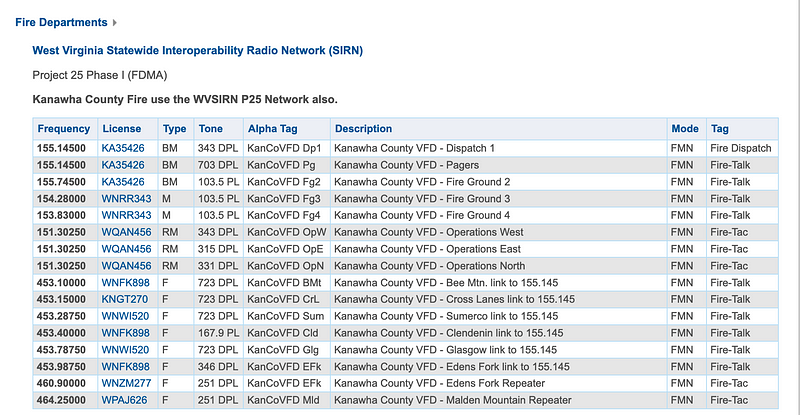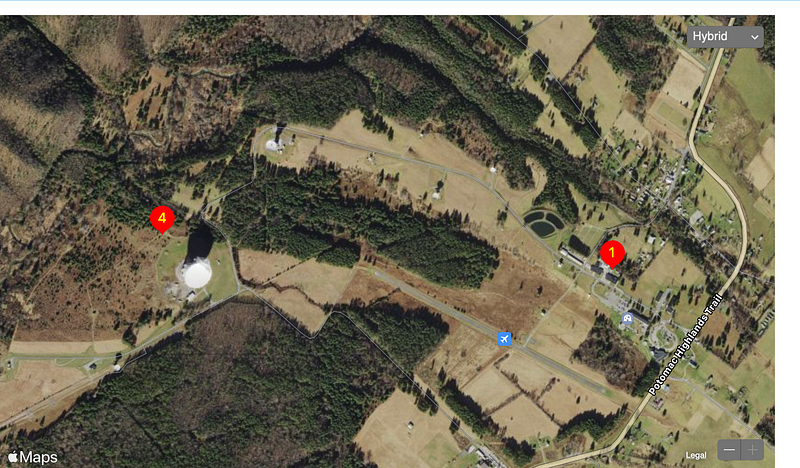Radio Reference Exploring: 25314

Radio Reference Exploring: From The Fire Department to the National Radio Astronomy Observatory
I started out by exploring the frequency bands in my home county (and current location), Kanawha County, West Virginia.
Initially, I went through various public safety frequencies, noting that most of them occured within a few ranges: 151.XXXX, 154–155, and 453–454. This seemed like a good opportunity to get more familiar with how different bands function and are divvied up, so I went through the Radio Reference Public Safety wiki to figure it out.
150–156 is the VHF business band, public safety, and other 2-way land mobile radio communications. I wasn’t able to find the exact range of this band, but judging by the fact that 3 separate fire operations licenses (West, East, and North) operate on the same frequency (151.30250), it seems like a safe bet that they’re operating at relatively short range in different parts of the county.
450–470 MHz is the UHF business band — roughly the equivalent of the 150–156 range in VHF. I spent a while trying to figure out the operating differences between these two bands, and am still scratching my head a bit, although thanks to Shure support I was able to figure out some basic differences: UHF has a drastically shorter wavelength than VHF, and has a lower potential transmission range using comparable amounts of power. However, UHF allows for much higher bandwidth and a wider frequency range.

Pretty much every radio license listed in Kanawha County falls in either the VHF or UHF business bands. I did, however, find a list of trunked radio systems, which is a new and interesting concept to me. I’m still wrapping my head around it, but it’s basically a packet-switching network over the radio band, creating connections between different users by automatically selecting a frequency for them. Unlike normal two-way radios which operate on a single frequency, these use pools of channels to allow many users to have private conversations at once. I wasn’t able to find the frequency ranges that these use, however, which I’d be interested to see.
I learned a few new things about radio from this search, but I didn’t find anything really weird, so I decided to search Radio Reference for Green Bank, WV — home to the Green Bank Observatory, the world’s largest steerable radio telescope. Surely they’re doing something interesting, right?

This was the first time I found licenses registered on the low end of VHF. This range, according to Wikipedia, is often used for licensed 2-way communication, mixed communication, and military purposes. I checked out the license and it looks to be communication between two radio towers, one at the telescope itself and one at the operations base.

The license notes only say “APPLICANT IS AN EDUCATIONAL NOT FOR PROFIT ORGANIZATION CONTRACTED TO OPERATE THE NATIONAL RADIO ASTRONOMY OBSERVATORY. RADIO SYSTEM WILL BE USED FOR OFFICIAL PURPOSES.” I’m guessing this system is used for communication between scientists at the base and technicians operating the telescope. It seems like most of their long-distance research is now done over the internet, so I’m not sure if there’s any long-range data broadcasting going on (other than that of the telescope itself).
The telescope itself doesn’t appear to have a license, but their website says they operate at 18–116 GHz, falling safely between “super high” and “extremely high” frequencies. I’m guessing the sunk cost of operating at this level is so high that the FCC doesn’t regulate it (or the government just owns all these bands). Since these ranges aren’t susceptible to the limits the ionosphere imposes on transmission at lower frequencies, they can (with a truly giant dish and power supply) send signals through the atmosphere to perform radio imaging on celestial objects.

One other interesting thing I stumbled onto during my research is the National Radio Quiet Zone, which includes Pocahontas County where the telescope is located. This covers the observatory and several major naval broadcasting stations. Major restrictions are placed on broadcasting within 20 miles of the observatory, and cellular telephone use is super limited, in order not to interfere with the observatory’s work. The ski resort I used to go to as a kid, Snowshoe Mountain, is within that range, which explains why cell service is pretty much impossible to find there. This zone is also apparently popular with people who believe they suffer from “electromagnetic hypersensitivity” — a possibly psychosomatic reaction to electromagnetic fields. Weird stuff!